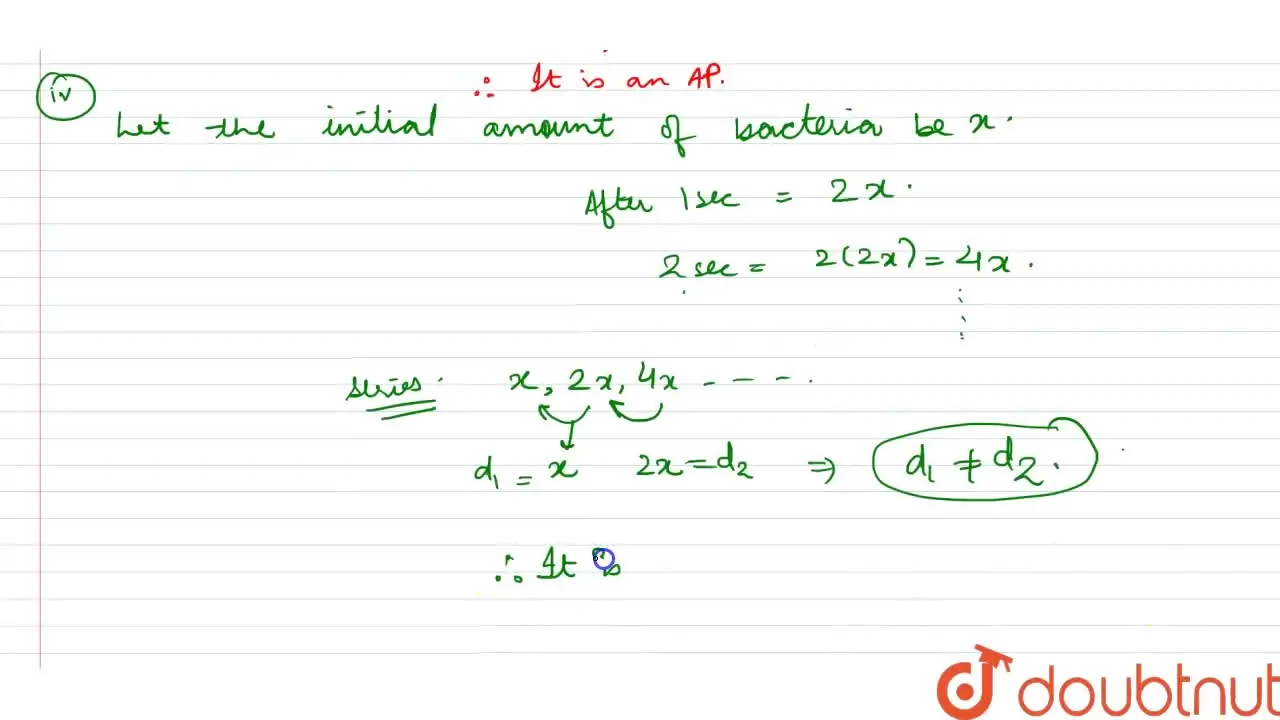In which of the following situations, do the lists of numbers involved form an AP? Give reasons for your answers.
(i) The fee charged from a student every month by a school for the whole session, when the monthly fee is Rs. 400.
(ii) The fee charged every month by a school from classes I to XII, When the monthly fee for class I is Rs. 250 and it increases by Rs. 50 for the next higher class.
(iii) The amount of money in the account of Varun at the end of every year when Rs. 1000 is deposited at simple interest of 10% per annum.
(iv) The number of bacteria in a certain food item after each second, when they double in every second.
(i) The fee charged from a student every month by a school for the whole session is
400,400,400,400,…
Which form an AP, with common difference (d) =400−400=0
(ii) The fee charged month by a school from I to XII is
250,(250+50),(250+2×50),(250+3×50),...
i.e, 250,300,350,400,...
which form an AP, with common difference (d) =300−250=50
(iii) Simple interest =Principal×Rate×Time100
=1000×10×1100=100
So, the amount of money in the account of Varun at the end of every year is
1000,(1000+100×1),(1000+100×2),(1000+100×3),...
i.e., 1000,1100,1200,1300,...
which form an AP, with common difference (d) =1100−1000=100
(iv) Let the number of bacteria in a certain food =x
Since, they double in every sceond.
∴x,2x,2(2x),2(2⋅2⋅x),...
i.e., x,2x,4x,8x,...
Now, let t1=x,t2=2x,t3=4x and t4=8x
t2−t1=2x−x=x
t3−t2=4x−2x=2x
t4−t3=8x−4x=4x
Since, the difference between each successive term is not same. So, the list does form an AP.
Related Playlists
Similar Questions
In which of the following situations, do the lists of numbers involved form an A.P. ? Give reasons for your answer.
The fee charged from a student every month by a school for the shole session when the monthly fee is Rs 400.View SolutionIn which of the following situations, do the lists of numbers involved form an A.P. ? Give reasons for your answer.
The fee charged every month by a school from Classes I to XII, when the monthly fee for Class I is Rs 250, and it increases by Rs 50 for the next higher class.View SolutionIn which of the following situations, do the lists of numbers involved form an A.P. ? Give reasons for your answer.
The number of bacteria in a certain food item after each second , when they double in every second.View SolutionIn which of the following situations, do the lists of numbers involved form an A.P. ? Give reasons for your answer.
The amount of money in the account of Varun at the end of every year, when Rs 1000 is deposited at simple interest of 10% per annum.View SolutionAre the following statements true or false? Give reasons for your answers.(i) Every whole number is a natural number.(ii) Every integer is a rational number.(iii) Every rational number is an integer.
View SolutionWhy didn't he pay the school fees on the day he brought money to school?
View SolutionState whether the following statements are true or false. Give reasons for your answers.(i) Every natural number is a whole number. (ii) Every integer is a whole number.(iii) Every rational number is a whole number.
View SolutionState whether the following statements are true or false . Give reasons for your answers.
(i) Every natural number is a whole number.
(ii) Every integer is a whole number .
(iii) Every rational number is a whole number .View SolutionWill the following be included in the national income of a country? Give reason for your answer.
(i) Scholl fees paid by students.
(ii) Purchase of new shares of a domestic firm.
(iii) Gifts received from abroad.
(iv) Furniture purchased by households.View SolutionThe quarterly school fee in Kendriya Vidyalaya for Class VI is Rs 540. What will be the fee for seven months?
View Solution


